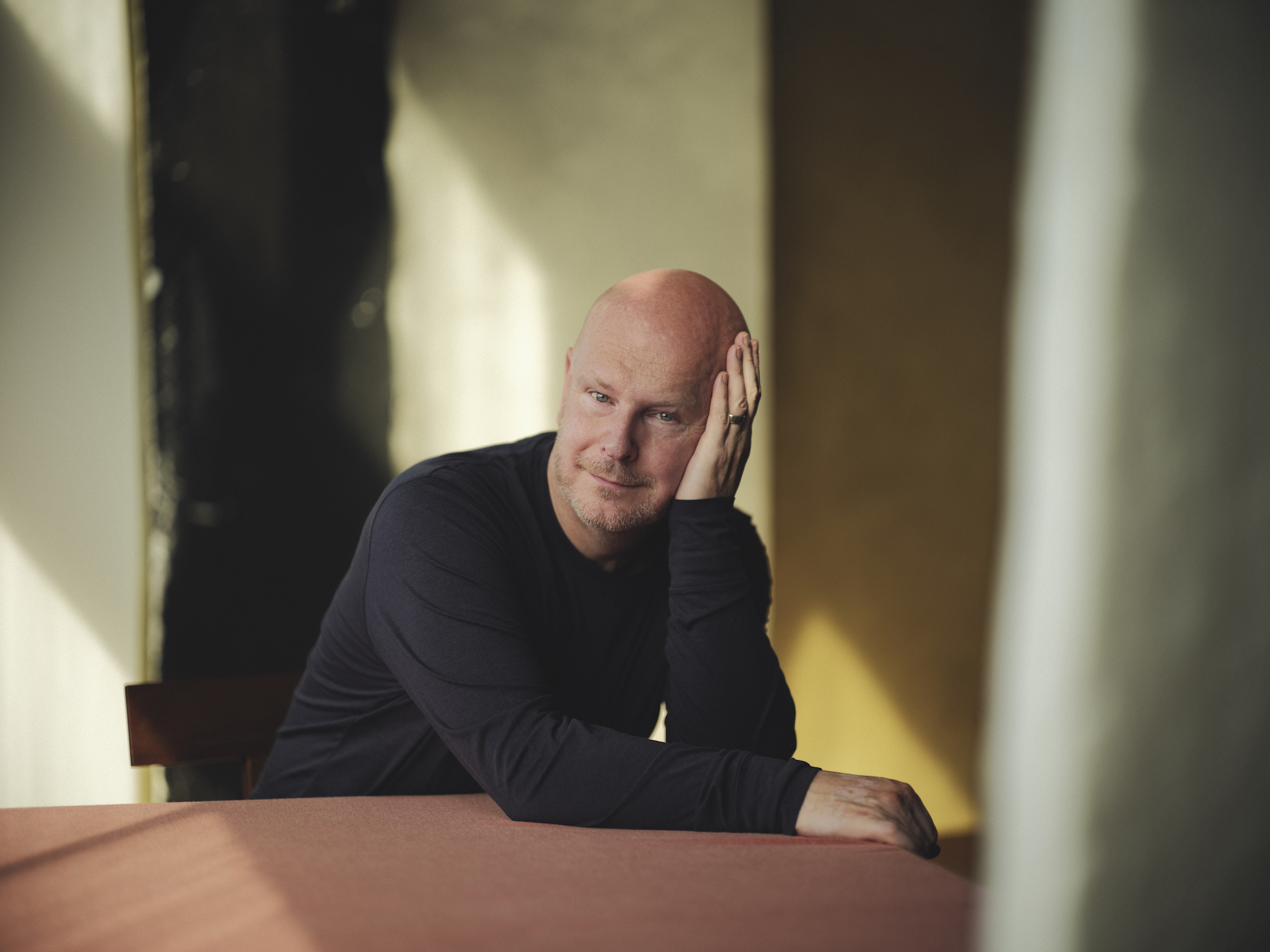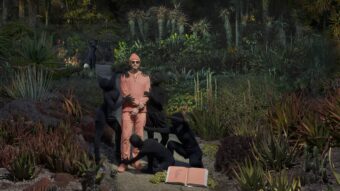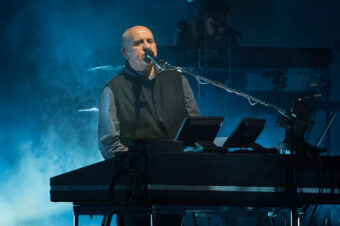Radiohead fans are often obsessive to the point of comedy — scouring Reddit, you’ll find oddly specific threads like “I think I’m starting to like ‘The Gloaming,'” “What’s the deal with Radiohead and Drew Barrymore?” and “HONEST OPINIONS ONLY: What do you think of Pablo Honey?”
So when the veteran art-rock band’s two most prolific members, Thom Yorke and Jonny Greenwood, launched The Smile in 2021, a lot of fans logged on to freak out and speculate about Radiohead’s future. (Some highlights: “Is it the end for Radiohead?” “The Smile is the new Radiohead,” and “The Smile is Radiohead LP10 in disguise.”) But if there’s been a breakup, no one told drummer Philip Selway.
“As far as I know, we’re still a band,” he tells SPIN over Zoom, laughing heavily through a playful smile. “If anybody knows any different, I’d be very interested.”
Even if Radiohead’s most recent tour wrapped in 2018, everyone in the crew has been pretty slammed lately. The Smile released their debut LP, A Light for Attracting Attention, last year, and they’ve already played nine non-album originals onstage. Guitarist Ed O’Brien has been recording new material following his 2020 solo debut, Earth. Bassist Colin Greenwood has been touring as part of Nick Cave‘s live band. And Selway will release his third solo record, the atmospheric Strange Dance, on Feb. 24.
“For me, whatever we do, it all falls under that umbrella of the five of us,” Selway says. “Ultimately, it all feeds into it.”
Radiohead aside, Strange Dance adds a compelling “electro-acoustic” dimension to his own wispy art-folk, drawing on the skills of a bigger musical cast: Portishead guitarist Adrian Utley (who also played on O’Brien’s Earth), string player and multi-instrumentalist Quinta, cellist Laura Moody, electronic singer-songwriter Hannah Peel, and drummer Valentina Magaletti.
Selway spoke to SPIN about expanding his solo sound, the jigsaw puzzle rhythms of “Pyramid Song,” and (inevitably) the future of Radiohead.
SPIN: Describing your new album, you wrote, “One of the things I’ve liked about [it] is it’s me as a 55-year-old not trying to hide that fact.” What exactly do you mean by that? Were you previously self-conscious about making music that reflected your age?
Philip Selway: Interesting question. I guess part of it [is that] people will know me most for what I’ve done in Radiohead. There’s a very clear idea of what we look like, and for lots of people, that’s probably caught up around [1997’s] OK Computer. A lot of life has happened in the interim. If you’re lucky enough to have 30-odd years [making] a living as a musician, you naturally develop over that time. I wanted to reflect that — not to feel like it was harkening back to a former time. There can be a temptation to mask the aging process in music or any kind of public-facing media. I think that can be a very limiting stance. You need to be confident in where you are.
You do seem confident here, even down to the core sonic concept: combining a singer-songwriter album with something more electronic and expansive. “What Keeps You Awake at Night” exemplifies that idea, contrasting your understated vocal with those swirling keyboards and screeching violins.
That’s definitely a track which pulled in all those different musical voices that I [envisioned]. I knew I wanted this big soundscape you could lose yourself in, but wrapped around this very intimate vocal. I knew what [the musicians] could bring to the record. There’s Adrian Utley and Quinta, who worked [with me] on a dance piece for the Rambert Dance Company in the U.K., revisiting the choreography of Merce Cunningham. There’s Laura Moody, a cellist who I’ve done a lot of work with for the soundtracks I’ve done. Hannah Peel’s music was a good influence on me, and she agreed to play on this record. She bridges those two worlds of electronic and acoustic, a very experimental approach.
How much of your music is considered in this sort of conceptual way? Radiohead is famous for that at times, searching for new pathways around Kid A and The King of Limbs.
I thought a lot about the overall sonics before we got into the studio. I had my dream team of musicians. But within that, you also want to leave the scope for when everybody’s bringing their ideas and be able to respond. When I was doing the initial session templates, I wanted to know that the songs could work as vocal and guitar or piano. But then I went into the studio with the attitude of “OK, that can all be stripped out. That’s just a platform to work from.” It was a very fluid process.
Apparently you started to play drums on this album, but ultimately stepped aside. Why?
I started that process, and little bits of my drumming are on there. But I was very much coming from the overview on all the pieces — it just wasn’t my drumming head. When you’re trying to keep your head around the overall arrangements, the details you need to find in the drumming might not happen as you want. There’s also the physical side of it, which is that I’ve not been drumming as much as I’d like coming into the sessions. I [knew] the textures of the drumming that I wanted on the record, and I had a chat with [the album’s producer] Marta Salogni, who suggested a drummer/percussionist called Valentina Magaletti. She came in and breathed this whole new life into the material, which became this lovely bed to explore all these other voices on top.
I was surprised by the attack and drive of “Picking Up Pieces.” The guitars remind me of Wilco at their most ragged.
We started making actual tape loops of my guitar, and the loops were then left out in the garden for a week. They took on all the degradation that happens within that, leaving this really lovely texture, and we made the basis of the track around that. Valentina came in and did this very motorik drum pattern on there which gave this momentum to the whole piece. I remember Adrian Utley prepared the guitar in a particular way — it was almost like some kind of fork tucked in between the strings — he would just hit it, and it would vibrate very quickly. All those very percussive, rapid sounds is Adrian on the guitar. Laura Moody came up with this really incredible string arrangement on there as well — kind of [like] soul strings but very angular.
As a Radiohead nerd, I have to ask about your drumming in “Pyramid Song.” All these years later, I’m still baffled by how you decoded that rhythm. How do you count that song, and how did you approach building the drum track?
On the count side of things, it is just a 4/4. I hate to admit.
But the feel is so strange!
Yeah, it swings within that. I don’t count, though. [Laughs.] I felt my way through that drum part more than counting it. I remember the day we were recording it, part of me was lost with what to do, and it didn’t feel like it was turning into a very successful session. But once I actually stopped trying to analyze the song rhythmically, I just allowed the playing to happen and responded to the inflections in Thom’s piano and vocal. The part fell into place. I was quite surprised by how it turned out, because at the start of the session, it did not sound good. [Laughs.] I went to see a really good dance piece last night in London called Ruination, and they did a version of “Pyramid Song” that was utterly beautiful — just piano and contralto vocal. Oh, god. You come back with fresh ears to something that’s so familiar and think, “That’s a really good song, actually.” Thom did well. [Laughs.]
It’s crazy. If you look online, people count that song in so many wild time signatures.
There’s actually a book coming out based on how to interpret the rhythmic flow of “Pyramid Song.” [Laughs.]
Everyone in the Radiohead camp has been busy — including Thom and Jonny in The Smile. Have you heard their album?
Yes, of course! I went to see them earlier [in 2022] when they were doing their initial livestream shows in London. I hadn’t heard the record before that point. I just love the dynamic between them: Thom and Johnny, that was fascinating. Normally, I hear them play and I’m [seated] behind them, so to see it from the other side was fantastic. And then with Tom Skinner, whose drumming is incredible. There’s always these amazing grooves happening — Tom comes from a jazz background and has all those jazz chops. I think there’s a particular dynamic between the five of us [in Radiohead], which I think we’re all so proud of. It’s developed from us basically learning our instruments together. But it’s such a healthy process when we step outside of Radiohead and reach beyond that, [when we] see what these other musical voices can do with your ideas.
Well, everyone seems to be doing that. Your solo work, Ed’s EOB album, Thom’s multiple projects, Jonny’s film scores…
Colin’s playing with Nick Cave! That’s the best gig ever, isn’t it?
Are there any rumblings of a Hail to the Thief box set, given the 20th anniversary in 2023? There are so many incredible B-sides for that album. It seems like the ideal choice for one of these enormous reissues.
Ummm… We’ve been very focused on the whole Kid A/Amnesiac thing, and I think that’s coming to its natural conclusion, going back through the reissue and [creating] the game scenario around that. We’re going to get together at the start of [2023], and I’m sure we’re going to start looking at other ideas for what comes next. Hail to the Thief — it’s a long time since that record, isn’t it?
Twenty years. I remember buying the album at FYE and begging the manager to let me have this enormous promo poster that hung on my wall for several years. My wife made me throw it away when we moved to a smaller apartment. I was crushed, but I guess I made the right call.
You prioritized future happiness, Ryan. I think that was the right choice.




